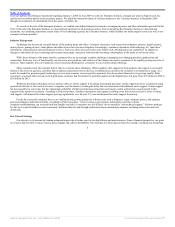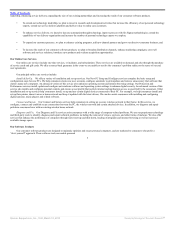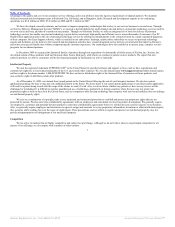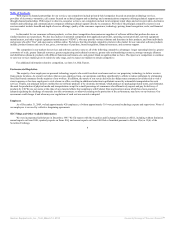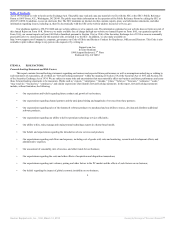Support.com 2009 Annual Report Download - page 14
Download and view the complete annual report
Please find page 14 of the 2009 Support.com annual report below. You can navigate through the pages in the report by either clicking on the pages listed below, or by using the keyword search tool below to find specific information within the annual report.
Table of Contents
launch or rollout of our services with even one of these channel partners could cause us to miss revenue targets. The process of establishing a relationship with a
channel partner can be complex and time consuming, and we must pass multiple levels of review in order to be selected. If we are unable to establish a sufficient
number of new channel partners on a timely basis our sales will suffer. There is also the risk that, once established, our programs with these channel partners may
take longer than we expect to produce revenue or may not produce revenue at all. One or more of our key channel partners, including Office Depot, may also
discontinue selling our services, offer them only on a limited basis or devote insufficient time and attention to promoting them to their customers. Some of our
partners may prefer not to work with us if we also partner with their competitors. If any of these key channel partners merge with a competitor, all of these risks
could be exacerbated. Each of these risks could reduce our sales and significantly harm our operating results.
If we fail to hire, train and manage our personal technology experts in a manner that provides an adequate level of support for our customers, our
reputation and financial performance could be harmed.
Our business depends in part on our ability to attract, manage and retain our personal technology experts in order to satisfy demand for our services. If we
are unable to hire, train and manage adequate numbers of competent personal technology experts, our service levels could decline, which could harm our
reputation, cause us to lose customers and channel partners and adversely affect our financial performance. Although our service delivery and communications
infrastructure enables us to monitor and manage these personal technology experts remotely, because they are home-based and geographically dispersed, we
could experience difficulties meeting services levels. In addition, any problems we encounter retaining personal technology experts could seriously jeopardize
our service delivery operations and our revenue.
From time to time, we enter into relationships with third parties to provide on-site services for certain customers. We may be less able to manage the
quality of services provided by third-party onsite service providers as directly as we would our own employees. In addition, providing these services may be
more costly. We also face the risk that disruptions or delays in these third parties’ communications and information technology infrastructure could cause lengthy
interruptions in the availability of our services. Any of these risks could harm our operating results.
Disruptions in our information technology and service delivery infrastructure and operations, including interruptions or delays in service from our
third-party web hosting provider, could impair the delivery of our services and harm our business.
We depend on the continuing operation of our information technology and communication systems and those of our external service providers. Any
damage to or failure of those systems could result in interruptions in our service, which could reduce our revenues and damage our reputation. The technology we
use to serve customers is hosted at a third-party facility located in the United States. This facility is operated by a publicly held company specializing in operating
such facilities, and we do not control the operation of this facility. As it briefly did recently, this facility may experience unplanned outages and other technical
difficulties, and it is vulnerable to damage or interruption from fires, floods, earthquakes, telecommunications and connectivity failures, power failures, and
similar events. This facility is also subject to risks from vandalism, break-ins, intrusion, and other malicious attacks. Despite substantial precautions taken, such
as disaster recovery planning and back-up procedures, a natural disaster, act of terrorism or other unanticipated problem could cause a loss of information and
data and lengthy interruptions in the availability of our services and hosted solutions offerings, as our backup systems may not be able to meet our needs for an
extended period of time. We rely on hosted systems maintained by third-party providers to deliver technology services to consumers, including taking customer
orders, handling telecommunications for customer calls, and tracking sales and service delivery. Any interruption or failure of our internal or external systems
could prevent us or our service providers from accepting orders and delivering services, or cause company and consumer data to be unintentionally disclosed.
Our continuing efforts to upgrade and enhance the security and reliability of our information technology and communications infrastructure could be very costly,
and we may have to expend significant resources to remedy problems such as a security breach or service interruption. Interruptions in our services resulting
from labor
13
Source: Support.com, Inc., 10-K, March 12, 2010 Powered by Morningstar® Document Research℠



